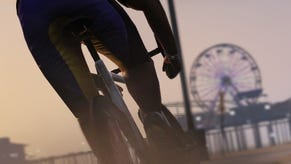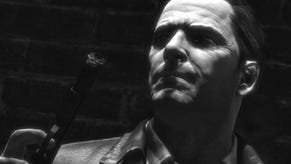Face-Off: Max Payne 3
Everything ripped apart in a New York minute.
| - | Xbox 360 | PlayStation 3 |
|---|---|---|
| Disc Size | 7.7GB (disc one) and 7.4GB (disc 2) | 14.45GB |
| Install | 7.7GB (disc one) and 7.4GB (disc 2) | 5.5GB (mandatory) |
| Surround Support | Dolby Digital | Dolby Digital, 5.1LPCM |
It's the middle of May, and right on cue a new Rockstar game is making some big noise around our local cinema spots and bus stop ad-boards. Revolutionary for its use of a trendy Bullet Time mechanic, and for having an early stab at object-based physics and face-mapping (with some memorably quirky results), Max Payne was something of a flagship third-person shooter for PC back in 2001, and it's a welcome sight to see the series return with such commercial pizazz.
The action-shooter scene has changed though, especially with games like Uncharted 3 laying down the gauntlet. Today, Max Payne 3 is being delivered to us as a major Rockstar Vancouver production on PS3, 360 and PC, rather than by its original creators at Remedy Entertainment - now of a stronger association with the Alan Wake series. Alas, the PC version will be arriving a little later on, being etched in for a 1st June release, and reportedly boasting some extraordinary recommended specs that could either be indicating that it'll be a much grander realisation of the game or simply an uneven port-job. Only time will tell on that one. (At least until we do.)
Either way, for now it appears Max Payne 3 has been tailored tightly to the dimensions of both console formats, where we find RAGE (Rockstar Advanced Game Engine) being reprised and re-purposed for a more linear 10-12 hour experience. It's clear the studio's time and effort has been poured into developing a slick, cinematic action game, as opposed to arduously realising the large sandbox worlds we're used to seeing in their previous games. As a result, details in everything from character models, facial animations and texture quality are inevitably ratcheted up a notch, and in terms of visual flair, we end up with a game that gets very close to its cinematic aspirations.
But given the luxury of choice between the PS3 and 360 versions, and in anticipation of the PC release, we're left asking ourselves which is currently the best way to experience this latest instalment in the series. Let's start off by taking a customary look at a face-off video and our Max Payne 3 720p comparison gallery, which shows directly like-for-like shots from the game.
"In strictly visual terms, there are a number of differences between the two formats - both major and minor - but the native resolution utilised by each isn't an issue."
In strictly visual terms, there are a number of differences between the two formats - both major and minor - but the native resolution utilised by each doesn't rank as one of them. Both versions run with a full 1280x720 framebuffer - a significant leap forward for the engine on PS3 in particular, given its history of running games like Grand Theft Auto 4 at sub-HD resolutions. Here we see a very close match in visual fidelity that brings out the best in texture assets and normal mapping - which, again, are of equal quality on both consoles.
To back this up, however, we do see differing implementations of anti-aliasing on each console, with the traditional multi-sample approach sidelined in favour of newer (but varying) post-processing methods. In a direct comparison, the resulting image quality on PS3 appears favourable in terms of overall sharpness and clarity, where an additional blurring to the 360 image seems evident on smaller, distant details. We see the rain splatter on the puddles of an early dock level lacking the same punch as a result, and, indoors, the outlines of cabinets and blinking computer lights are smudged over a touch. Simply put, the further into the distance you look, the less defined these details become.
On the plus side, all the instances of aliasing on 360 look to be more thoroughly addressed, which gives the impression of a much smoother image in practice. This benefits some levels more than others, where the high-contrast edges we see in one neon-lit club stage are easier on the eye for the way the jaggies are handled. This is a trade-off that could ultimately comes down to personal preference - in the absence of more demanding methods: to blur, or not to blur?
As we see in the images below, there are also some occasional but drastic changes to the way some scenes are constructed. In one case we see light sources are repositioned for a more dramatic effect on 360, while a similar array of lights appear on the opposite side of the stadium later on for PS3. This is a curious difference, and is a similar story for splash effects on Sony's console during one scene - unseen in that moment, even though it's capable of achieving these effects elsewhere. Perhaps jumping ahead a bit, but we notice that our FPS analysis of these moments reveal a lead in performance on PS3, indicating that these changes were likely made for precisely that end.
"Basic assets are nigh-on identical across the board with little to distinguish the two versions, but pop-in of trees and rocks is slightly more pronounced on PS3 during vehicle-based sections."
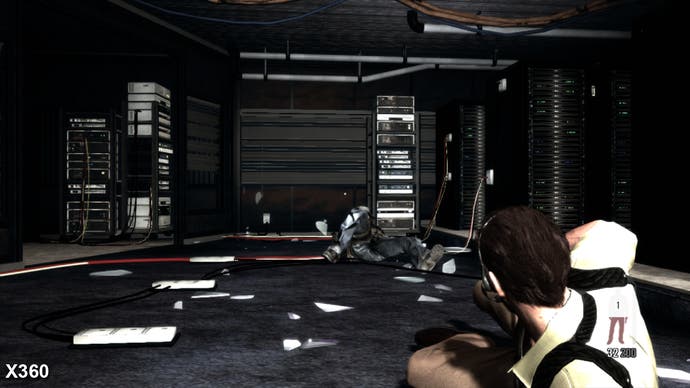
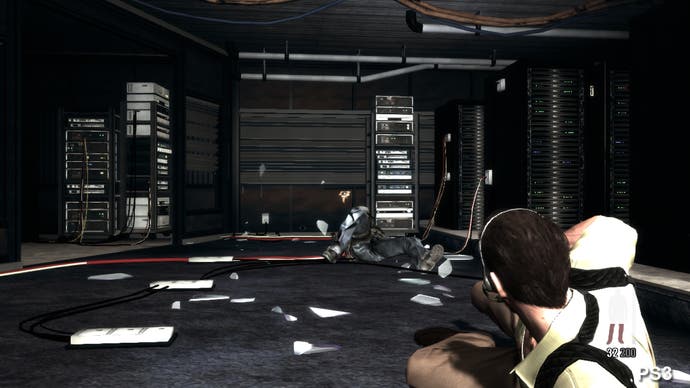
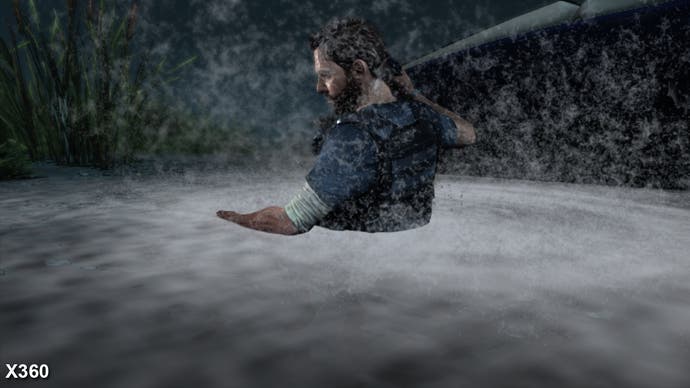
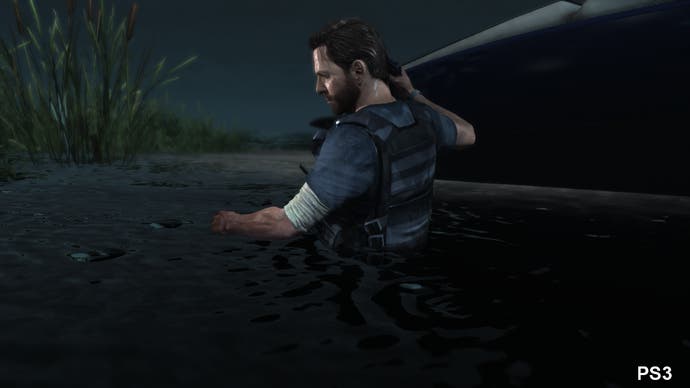
Updated: Eagle-eyed readers have pointed out that the stadium floodlights are present in their playthrough of the game on PS3. After investigating, we've found that this is indeed a glitch caused by restarting a checkpoint on that level, where doing so leads to elements of that cut-scene failing to reload. As an example of missing effects on PS3 this is not representative, so we've updated the images to show another alteration made to its cut-scenes, which is consistent and repeatable.
Rockstar's Engine: From The Sandbox To The Corridor
As mentioned, the basic assets are nigh-on identical across the board, with little to distinguish the two in terms of texture quality and character detail. The rate at which these assets are drawn in varies slightly though, where pop-in of trees and rocks is slightly more pronounced on PS3 during vehicle-based sections where you happen to move very fast across terrain. This doesn't represent the majority of play. Outside of a boat ride and a car chase, Max Payne 3's gameplay is generally built around confined spaces which you navigate by foot.
In fact, the way Max interacts with these environments easily counts as this engine revision's biggest step forward. The leading man slumps against walls that he lands against at the tail-end of a dive, with his body buckling with a level of realism that makes you question his endurance. The animation is just as impressive on enemies too, who flinch and flail according to where you place your shots - each of which is delivered through a fully-rendered bullet which passes through select spots. Destructible cover is also a big feature, and, much like the crumbling walls in Battlefield 3, has a tangible effect on your continued safety behind select surfaces.
All this remains identical and fully featured across both consoles, making for a game that looks stunning when slowed down to reveal the impact of each shot. Similarities between the two versions go right down to the bloom, and light shafts that crop up behind clouds and trees. Plus the distinctive colour-splitting post-processing effect we see remains present and correct on each; a bit overbearing at times, but this in theory accounts for Max's increasingly debilitated state of mind.
One sizeable difference is in the way foliage is treated on both platforms. The 360's heavy-handed use of an edge-detection algorithm affects the appearance of plants quite drastically, giving their flourishes a fuller, darker look. By comparison, close-ups show individual leaves on PS3 to be noticeably more thinned-out - sometimes to the point of invisibility from certain angles, where their details are somehow thinner than the pixels in place to represent them. Curiously, densely packed swathes of plant life on the later dock levels also appear to be pared back on PS3, similar to the way grass tufts are culled from plains in Read Dead Redemption - but this is really only noticeable in a direct face-off environment.
"Edge-detection algorithms give foliage on 360 a fuller, darker look - by comparison, close-ups show individual leaves on PS3 to be noticeably more thinned-out, sometimes to the point of invisibility."
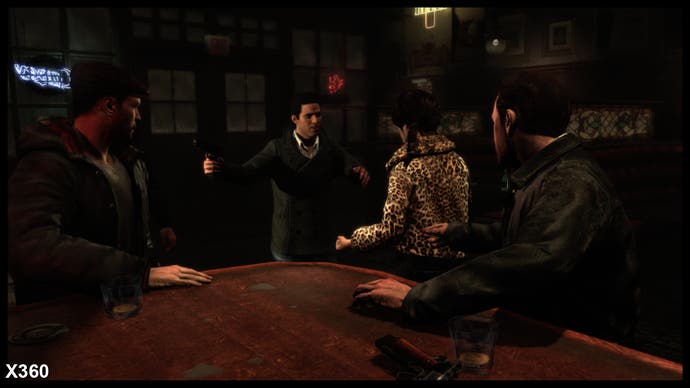
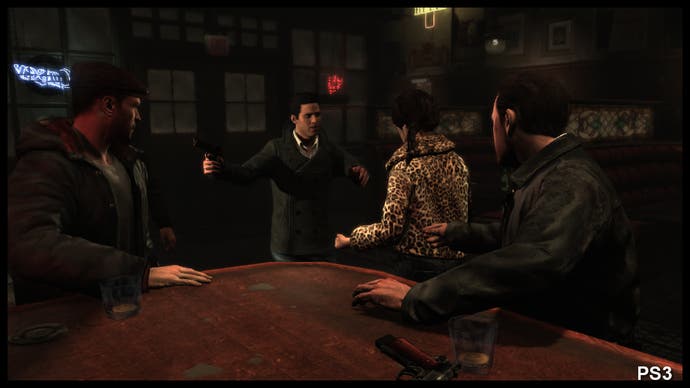
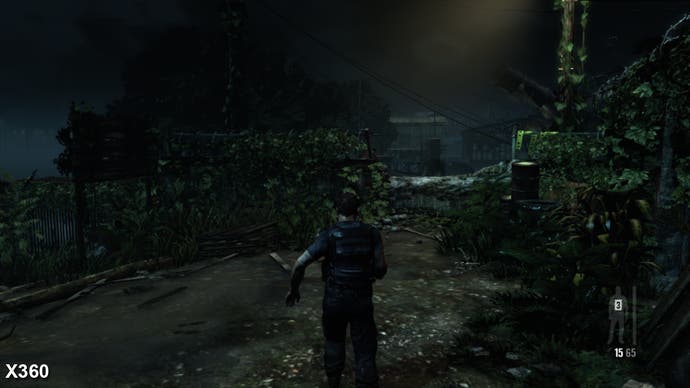
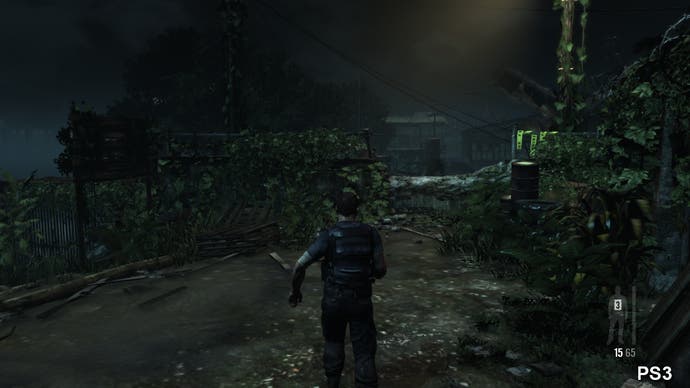
Shadows are of matching quality, which is thankful considering the Max Payne series' debts to film-noir as a stylistic reference point, though it seems there's a permanent offset across the game world which distinguishes the two versions. In effect, this causes shadows to cast out from objects at differing angles on both platforms - indoors or out - which by direct comparison can look more logical on 360. Otherwise, character self-shadowing is present and correct on both platforms, with a blockiness and flicker on movement that appears like-for-like.
Similarities also extend to each format's liberal use of full-motion videos. Looking at the disc sizes, we notice that the 360's two DVDs add up to a total of 15.1GB, while the PS3 copy ships on a single 14.45GB Blu-ray. The difference in overall size can be accounted for by the way video data is distributed. Picking apart the directories for each version reveals that the Bink encoded video files are identical across each format down to the bit, though the 360 does use up 560MB of extra space in order to duplicate some of these assets across both discs - mostly taken up by the "attract" movie sequence on the intro screen, where Max is sat drinking in his New York apartment.
Given how regularly (and seamlessly) these videos weave in and out of the in-engine cut-scenes, it's to Rockstar's credit that no compromise has been made to the encoding quality on 360, forcing a crucial two-disc split. There's little sign of any macro-blocking, and they're often indistinguishable from the actual in-engine cut-scenes, which completes the illusion.
Bink is well suited to these kinds of adventure titles; the minimal processing demands of the decoder allows for these videos to play out while actual level assets stream into RAM in the background. As Max globe-trots between the snowy New York streets and the run-down Sao Paolo favelas, this successfully stitches each stage together, avoiding any apparent break in the narrative flow which the game is so keen to uphold. As a result, the only loading screen you'll see is on loading a chapter at the start, which, we have to admit, makes it difficult to know when to stop and take a breather.
RAGE: A Stable Performer On Both Consoles?
So with the 360 commanding a slight advantage on the visual front, how do they actually perform by comparison? A habit of the engine we noticed in GTA4 is that the 360 version typically runs with an unlocked frame-rate while PS3 is capped to a targeted 30FPS at all times, thanks to a permanently engaged v-sync. We ran some synchronised footage from both cut-scenes and gameplay through our FPS analysis tools to get a feel for their strengths and weaknesses.
The results are rather mixed, but the good news is that Max Payne 3 is an overall solid performer on both formats. In most cases we find the 360 holds the higher frame-rate by virtue of simply being unlocked, meaning it can hit peak values of 35FPS when there's little action, while the PS3 nestles in at the standard 30FPS in likewise scenarios. Meanwhile, water shaders and alpha effects used for splashes are culpable for the biggest hits on both, bogging the engine down on in equivalent spots, albeit with a noticeably greater impact on PS3 during that first scene where Max slides down into the pool.
"In most cases we find the 360 holds the higher frame-rate by virtue of simply being unlocked, meaning it can hit peak values of 35FPS when there's little action, while the PS3 nestles in at the standard 30 frames per second."
The tables do turn during later scenes, however, such as during the bar fight in New York and the break-in at the football stadium, where we catch the 360 sticking to a lower frame-rate for prolonged spells. This has little in common with the readings we see for open-world games like Red Dead Redemption, where the PS3 is the first to drop frames by a clear margin. Here, however, there's little to conclusively distinguish the two based on like-for-like cut-scenes alone.
It's also worth mentioning that screen-tear is entirely non-existent on the v-synced PS3 version, and isn't detectable at any point on 360, even within its overscan area (as was occasionally the case with GTA4). This is a huge boon to a game which prides itself on replicating the look of modern-day action thrillers - a cinematic look, where both consoles prioritise the integrity of each frame over a perfectly smooth refresh.
So with all things being relatively close, we look to the bread and butter of the Max Payne experience; the wild, no-holds barred shoot-outs with slow motion jumps, gun-toting packs of enemies and destructible environments.
The over-riding impression during these action set-pieces is that the 360 can handle a marginally more consistent frame-rate. It's the Bullet Time sequences that hit hardest, in tandem with one too many characters on-screen that cuts into the responsiveness of the PS3 version. This makes for some especially jarring 12FPS (!) motion during one particular shoot-out in the club stage, partially mitigated by the fact it's all in slow motion. However, outside of that scenario, there are few other drops which conflict with playability of the rest of the game to that same extent.
There are occasions where we also find the PS3 stutters when returning fire during the "last chance" shoot-outs (where you need to shoot your assailant to survive). On pulling the trigger, there's often a momentary delay before we see the slow-motion animation of the bullet careening towards the enemy play out- a blip in response not present on 360.
Max Payne 3: The Digital Foundry Verdict
"It's fair to say that Rockstar Vancouver has effectively translated its hard-boiled action game to both platforms, and you can fully enjoy the ride on either."
Looking at the overall turn-out for each version of Max Payne 3, it's fair to say Rockstar Vancouver has effectively translated its hard-boiled action game to both platforms, and you can fully enjoy the ride on either. When it comes to image quality, while the PS3 version offers a slightly sharper picture, the 360 does hold up some advantages that are more considerable to those on the bench, such as the effectiveness of its anti-aliasing, and the more flattering treatment of foliage elements.
There is also the curious issue of missing effects during specific PS3 cut-scenes, though these crop up in entirely isolated instances, where in other areas they're rendered properly. These small nips and tucks are evidently to the benefit of the frame-rate on PS3, which otherwise isn't quite as consistent as the 360 during the majority of shoot-outs. Performance is still entirely serviceable to gameplay on both platforms though, and the sense of cinematic spectacle is held up - in no small part thanks to the way core video assets and native resolutions are identical to the pixel on each platform.
For multi-platform owners unsure of which version to opt for, we'd have to give a nod to the 360 version, though it remains to be seen what advantages the eventual PC release offers. With its reported support of the DirectX 11 API, stereoscopic 3D, and with an install size listed at a whopping 35GB, it seems Rockstar is taking the conversion quite seriously. Whether that feature list translates to a tangibly superior game worth waiting a few extra weeks for though, we'll have to wait and see.






